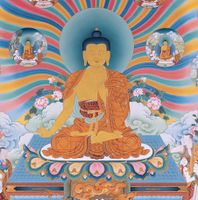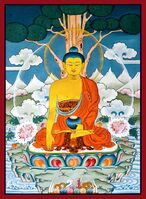Śākyamuni: Difference between revisions
No edit summary |
m (Text replacement - "{{Footer}}" to "") |
||
| (2 intermediate revisions by 2 users not shown) | |||
| Line 1: | Line 1: | ||
{{Person | {{Person | ||
|HasDrlPage=Yes | |||
|HasLibPage=Yes | |||
|HasBnwPage=Yes | |HasBnwPage=Yes | ||
| | |MainNamePhon=Śākyamuni Buddha | ||
| | |SortName=Śākyamuni | ||
|MainNameTib=ཤཱཀྱ་ཐུབ་པ་ | |MainNameTib=ཤཱཀྱ་ཐུབ་པ་ | ||
|MainNameWylie=shAkya thub pa | |MainNameWylie=shAkya thub pa | ||
|MainNameDev=शाक्यमुनि | |MainNameDev=शाक्यमुनि | ||
|MainNameSkt=Śākyamuni | |MainNameSkt=Śākyamuni | ||
|AltNamesOther=Siddhārtha Gautama | |PersonType=Classical Indian Authors | ||
|images=File:Shakyamuni Buddha.jpg | |||
File:Shakyamuni Buddha Fynn Photograph.jpg | |||
File:THA 16421-6265 Shakyamuni.jpg | |||
|AltNamesWylie=shakya thub pa | |||
|AltNamesOther=Siddhārtha Gautama; Buddha Shakyamuni | |||
|BnwShortPersonBio=In Sanskrit, “Sage of the Śākya Clan,” one of the most common epithets of Gautama Buddha, especially in the Mahāyāna traditions, where the name Śākyamuni is used to distinguish the historical buddha from the myriad other buddhas who appear in the sūtras. The Śākyas were a tribe in northern India into which was born Siddhārtha Gautama, the man who would become the historical buddha. According to the texts, the Śākya clan was made up of kṣatriyas, warriors or political administrators in the Indian caste system. The Śākya clan flourished in the foothills of the Himālayas, near the border between present-day Nepal and India. (Source: "Śākyamuni." In ''The Princeton Dictionary of Buddhism'', 741. Princeton University Press, 2014. http://www.jstor.org/stable/j.ctt46n41q.27.) | |BnwShortPersonBio=In Sanskrit, “Sage of the Śākya Clan,” one of the most common epithets of Gautama Buddha, especially in the Mahāyāna traditions, where the name Śākyamuni is used to distinguish the historical buddha from the myriad other buddhas who appear in the sūtras. The Śākyas were a tribe in northern India into which was born Siddhārtha Gautama, the man who would become the historical buddha. According to the texts, the Śākya clan was made up of kṣatriyas, warriors or political administrators in the Indian caste system. The Śākya clan flourished in the foothills of the Himālayas, near the border between present-day Nepal and India. (Source: "Śākyamuni." In ''The Princeton Dictionary of Buddhism'', 741. Princeton University Press, 2014. http://www.jstor.org/stable/j.ctt46n41q.27.) | ||
|BuNayDefProvComplex=No | |||
|BuNayWheelTurnComplex=No | |||
|BuNayYogaMadhyaComplex=No | |||
|BuNayZhenRangComplex=No | |||
|BuNayVehiclesComplex=No | |||
|BuNayAnalyticMeditComplex=No | |||
|BuNayEmptyLuminComplex=No | |||
|IsInGyatsa=No | |IsInGyatsa=No | ||
|pagename=Śākyamuni | |||
|classification=People | |classification=People | ||
}} | }} | ||
== Names == | == Names == | ||
*[[shakya thub pa]] | *[[shakya thub pa]] | ||
*[[Buddha Shakyamuni]] | *[[Buddha Shakyamuni]] | ||
Latest revision as of 14:50, 5 June 2024
| PersonType | Category:Classical Indian Authors |
|---|---|
| MainNamePhon | Śākyamuni Buddha |
| MainNameTib | ཤཱཀྱ་ཐུབ་པ་ |
| MainNameWylie | shAkya thub pa |
| MainNameDev | शाक्यमुनि |
| MainNameSkt | Śākyamuni |
| SortName | Śākyamuni |
| AltNamesWylie | shakya thub pa |
| AltNamesOther | Siddhārtha Gautama · Buddha Shakyamuni |
| IsInGyatsa | No |
| BnwShortPersonBio | In Sanskrit, “Sage of the Śākya Clan,” one of the most common epithets of Gautama Buddha, especially in the Mahāyāna traditions, where the name Śākyamuni is used to distinguish the historical buddha from the myriad other buddhas who appear in the sūtras. The Śākyas were a tribe in northern India into which was born Siddhārtha Gautama, the man who would become the historical buddha. According to the texts, the Śākya clan was made up of kṣatriyas, warriors or political administrators in the Indian caste system. The Śākya clan flourished in the foothills of the Himālayas, near the border between present-day Nepal and India. (Source: "Śākyamuni." In The Princeton Dictionary of Buddhism, 741. Princeton University Press, 2014. http://www.jstor.org/stable/j.ctt46n41q.27.) |
| Other wikis |
If the page does not yet exist on the remote wiki, you can paste the tag |



